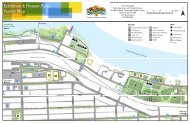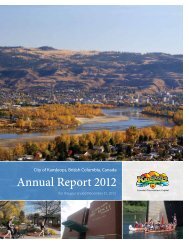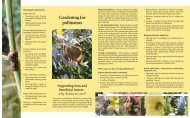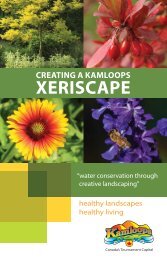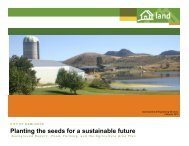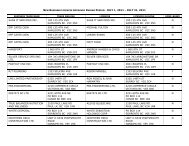GEOTOUR GUIDE - City of Kamloops
GEOTOUR GUIDE - City of Kamloops
GEOTOUR GUIDE - City of Kamloops
You also want an ePaper? Increase the reach of your titles
YUMPU automatically turns print PDFs into web optimized ePapers that Google loves.
hoW Would a GeoGrapher desCriBe <strong>Kamloops</strong>?<br />
<strong>Kamloops</strong> lies at the junction <strong>of</strong> two major rivers, as do the communities <strong>of</strong> Prince George, Quesnel, Lytton, and Grand Forks.<br />
<strong>Kamloops</strong> is also built in part on a river delta, similar to Vancouver’s suburbs <strong>of</strong> Richmond and Delta. <strong>Kamloops</strong> has spread from<br />
the shores <strong>of</strong> the Thompson Rivers up the valley slopes to the plateau to the south, a vertical distance <strong>of</strong> about 500 metres. This<br />
elevation gain may be the greatest <strong>of</strong> any Canadian city. Nelson, West Vancouver, and North Vancouver are other contenders for<br />
that title. This elevation difference creates tremendous climatic variation within the city limits. Snow lasts about two months<br />
longer in the uplands that in the valley below. However, inversions during the winter can trap a cold heavy fog in the valley<br />
while the uplands can remain bright and warm. It may also be the hottest city in Canada, at least in the valley bottom. Because<br />
<strong>of</strong> that elevation difference, there are three biogeoclimatic zones (bunchgrass, ponderosa pine, and interior Douglas fir) within<br />
the city limits. You pass through all three zones on the trail up to the Highlander lookout. This elevation difference also makes<br />
water supply expensive – water from the South Thompson River has to be pumped as much as 500 metres uphill to reach all<br />
parts <strong>of</strong> the city.<br />
ClimaTe ChanGe impaCTs: dyinG foresTs and spreadinG Grasslands<br />
Climate scientists predict that grasslands in southern BC will expand farther north and to higher elevations as our climate<br />
warms and summer temperatures rise. Pest infestation and forest fires are two <strong>of</strong> the mechanisms by which this change<br />
will take place. Extensive areas <strong>of</strong> dead pine forests due to mountain pine beetle infestation are visible from the lookout.<br />
Drought-tolerant grasslands better suited to the changing climate may permanently replace these forests.<br />
How to get to Kenna CartwrigHt parK. Drive west from downtown on Highway 1. Exit on to<br />
Copperhead Drive (Exit 366). Turn left on Hillside Drive; Kenna Cartwright Park entrance is about 200 metres to<br />
the west. From the parking lot, take the Tower Trail up Mount Dufferin to the lookout near the telecommunication<br />
towers. It is a pleasant half hour climb up through grasslands (south-facing slopes), Ponderosa pine parklands (higher<br />
south facing slopes), and Douglas fir forests (in the valley and north-facing slopes) – note that topography controls<br />
vegetation.<br />
alternate stop: <strong>City</strong> <strong>of</strong> <strong>Kamloops</strong> Scenic Lookout, Columbia Street. The <strong>City</strong> <strong>of</strong> <strong>Kamloops</strong> scenic lookout on the<br />
Columbia Street also provides an excellent view <strong>of</strong> the <strong>Kamloops</strong> landscape. The access road to the overlook is on the<br />
north side <strong>of</strong> Columbia, just uphill from the junction <strong>of</strong> Columbia and Grandview Terrace.<br />
8




